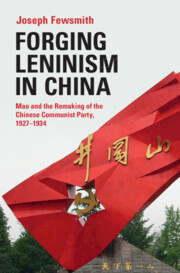Book contents
- Forging Leninism in China
- Forging Leninism in China
- Copyright page
- Dedication
- Contents
- Figures
- Maps
- Acknowledgments
- Introduction
- 1 Disaster and Local Rebellion
- 2 The Donggu Revolutionary Base Area
- 3 A Different Approach to Revolution
- 4 Mao versus Local Forces
- 5 The Logic of Sufan
- Conclusion
- Glossary
- Bibliography
- Index
Conclusion
Published online by Cambridge University Press: 03 February 2022
- Forging Leninism in China
- Forging Leninism in China
- Copyright page
- Dedication
- Contents
- Figures
- Maps
- Acknowledgments
- Introduction
- 1 Disaster and Local Rebellion
- 2 The Donggu Revolutionary Base Area
- 3 A Different Approach to Revolution
- 4 Mao versus Local Forces
- 5 The Logic of Sufan
- Conclusion
- Glossary
- Bibliography
- Index
Summary
The Conclusion reviews the arguments made in the previous chapters and argues the importance of the Donggu Revolutionary Base Area for understanding the Chinese revolution. It is impossible to ignore the conflicts between the local interests of the Donggu revolutionaries and Mao’s efforts to create a national revolution. It is also impossible to ignore the conflict between the Communist movement’s need for soldiers and money and the unwillingness of local society to provide either in sufficient quantity.
- Type
- Chapter
- Information
- Forging Leninism in ChinaMao and the Remaking of the Chinese Communist Party, 1927–1934, pp. 164 - 170Publisher: Cambridge University PressPrint publication year: 2022

